ace
Gold Member
- Joined
- May 3, 2000
- Messages
- 432
The BladeForums.com 2024 Traditional Knife is available! Price is $250 ea (shipped within CONUS).
Order here: https://www.bladeforums.com/help/2024-traditional/
Yes- no matter which steel you use the hardness doesnt change stiffness.Notice how the article doesn't specify the steel it talks about because the concept is relevant to all steels we are interested in. From the article:
View attachment 2527946
Buy what you love and love what you buy.
Jerry has done incredible things with whatever steels he’s used over the years. His A2 are still some of my favorite users. The SHBMs, they stand on their own, Fehrman did a great job on 3V for years till Carothers brought it to a new level. Siegle as well has 5160 competing with the best of the super steels…..
They have an understanding of their product that the rest of us speculate on and argue about aspects for pages upon pages. But truth is any of these knives will perform incredibly for years / decades without issues. The only complaints are these tards intentionally trying to break blades to prove what?! And believing their ability to break a knife shows some flaw and their input would make a better product.
There’s a reason their names are on the company and we are the consumers. With so many makers out there, find the ones that suit your needs and stick with them.

Yes- no matter which steel you use the hardness doesnt change stiffness.
That doesnt mean that choosing an entirely different steel wont.
"Since steel is primarily iron it is controlled by the strength of the iron- iron bonds"
As i mentioned before this SHOULD very clearly contradict your point as obviously different steels have different compositions ergo different amounts of iron ergo different iron- iron relationships.
You are reading into the article something that is opposite of what is there.
Nobody is arguing that geometry doeant affect flexibility but for 1/4 we are speaking of stiff and more stiff lolErgo, show me a 0.250" thick, 4" long flexible knife.
I've just realized that there is still something that hardness has to say, when it comes to stiffness and break resistance on lateral bending. If there wasn't, then I can't understand why the European thin swords (also named rapier) were standardly heat treated to a HRC in the 40 range rather than higher and katanas that had edges of +60 HRC needed to have differential HT with a spine in the 40+ range. Also why we cannot see springs that are heat treated to 60+ HRC in any industryThis doesn't make sense to me. How steels work is not really open for discussion, the article explains why different steels have same stiffness. I am really at a loss here. The information is available do with it what you like.
Within the realm of steels used in knife production, the difference between the most flexible steel and the stiffest steel amounts to little more than a rounding error. For all intents and purposes the modulus of elasticity of steel is roughly 30 million psi. There are some very slight differences from alloying but you would never be able to tell the difference. Stiffness is also almost completely unaffected by hardness and heat treat. For all practical purposes, the stiffness is based on the geometry only.
If you take a rectilinear beam and double its width, it will be twice as stiff. If you double it's thickness it will be eight times stiffer. ←That's really all you need to know.
Springs are not normally especially hard. But it is not the heat treat of the spring that makes it springy, it is the geometry. The hardness of the spring is selected so that, within the intended range of use of the spring it's elastic limit will not be exceeded. There is no purpose to going harder and a harder spring will have a shorter fatigue limit and a more drastic failure mode. The purpose of a spring temper has no effect on its "springiness".
Within the realm of steels used in knife production, the difference between the most flexible steel and the stiffest steel amounts to little more than a rounding error. For all intents and purposes the modulus of elasticity of steel is roughly 30 million psi. There are some very slight differences from alloying but you would never be able to tell the difference. Stiffness is also almost completely unaffected by hardness and heat treat. For all practical purposes, the stiffness is based on the geometry only.
If you take a rectilinear beam and double its width, it will be twice as stiff. If you double it's thickness it will be eight times stiffer. ←That's really all you need to know.
Springs are not normally especially hard. But it is not the heat treat of the spring that makes it springy, it is the geometry. The hardness of the spring is selected so that, within the intended range of use of the spring it's elastic limit will not be exceeded. There is no purpose to going harder and a harder spring will have a shorter fatigue limit and a more drastic failure mode. The purpose of a spring temper has no effect on its "springiness".
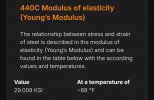
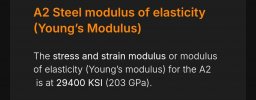
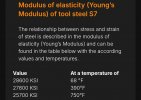
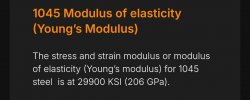

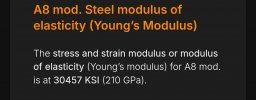
I can notice differences in steel while batoning, and unlike most users i have knives that are entirely identical in all but steel.
So first maybe to clarify a bit my flagship knife is .5" tall, .021" bte, .128" thickness and ffg so in that blade a difference in stiffness is more noticable than in a bigger chopper or something. I am working with a massive variety of steels but primarily right now 1v, s35vn, a2, and some baker forge san mai.There is, in fact, about a 10% difference in stiffness from D2 on one extreme to S7 on the other extreme. Not large, but certainly more than an actual rounding error.
I'm curious, of the knives that you baton with. What are those alloys and what is the difference in stiffness in those alloys? I would be curious to know how small of a difference in stiffness would be perceptible to a person. If you can feel that difference, that's pretty incredible. It would be an interesting experiment to remove the steel markings off of the knives and make them visibly identical and then duplicate your batoning experiment and see if you can determine which steel is which based on a few percentage difference in stiffness. Which would also amount to a few thousandths of an inch difference in thickness and could be a normal manufacturing variability.
It is my opinion that, to say that it amounts to a rounding error when discussing whether or not steel and heat treat are what dictate a knife's feel rather than its geometry, is essentially accurate. But if you disagree, that's okay.
